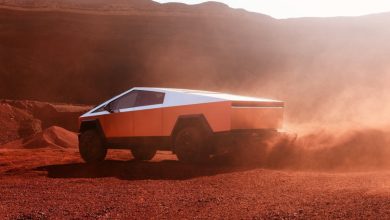Tesla’s Cybertruck Delivery Sparks Debate: Innovative Leap or Market Misstep?

Tesla has finally started delivering its long-awaited Cybertruck, marking its bold entry into the highly competitive and profitable pickup truck market. Unveiled last Thursday, the Cybertruck stands out with its futuristic design, featuring a stainless steel body and distinct sharp angles, setting it apart from traditional market leaders like Ford Motor, General Motors, and Ram.
Priced at $100,000 for the premium model, the Cybertruck is Tesla’s first new passenger vehicle in over three years. However, its launch comes significantly later than other electric pickups in the market, raising questions about its potential customer base. Despite Tesla announcing that hundreds of thousands have placed $100 refundable deposits, it remains uncertain if these will convert into actual sales.
“Tesla’s target market for the Cybertruck is not immediately clear,” comments Ben Rose, president of Battle Road Research. He likens the vehicle’s appearance to something from a lunar mission, highlighting its unique design.
At a recent event in Austin, Texas, where the Cybertruck will be manufactured, Tesla CEO Elon Musk addressed skepticism about the vehicle’s practicality. Demonstrations showcased the Cybertruck outperforming competitors in hauling and construction tasks, emphasizing its utility beyond being a mere showpiece.
Musk’s comments at the event followed his controversial statements regarding advertisers withdrawing from X, the social media platform he owns. He accused these brands of attempting to “blackmail” him, using strong language to emphasize his point.
Originally revealed in 2019, the Cybertruck’s journey to market has been hindered by production challenges, primarily due to its unconventional design and choice of materials. Musk has cautioned that mass production might not ramp up until 2025, acknowledging the difficulties in making the Cybertruck profitable.
The stakes are high not just for Tesla but also for traditional automakers. The pickup truck market in the U.S. is a lucrative segment, with luxury features often being a key selling point. Tesla’s entry with the Cybertruck could potentially disrupt this market.
Tesla’s website lists a more affordable $61,000 two-wheel-drive Cybertruck, available in 2025, with other models ranging from $80,000 to $100,000 launching next year. Initial buyers are expected to be tech enthusiasts and collectors, with the vehicle less likely to appeal to corporate fleet operators or small business owners.
Traditional automakers may find some solace in this. Ford, for instance, sells a significant portion of its F-150s to business and government clients, a market segment where the Cybertruck might not make significant inroads.
While electric pickups have seen modest sales to commercial customers, companies like Ford see potential in dominating this emerging market. Ford’s E-Transit electric vans and the electric F-150 Lightning are already making strides in this space, with Ford offering additional services like software for fleet management and assistance in setting up charging stations.
Tesla, on the other hand, has not indicated plans to offer similar services. The marketing for the Cybertruck focuses on its performance, comfort, and durability, with features like power outlets and the ability to power a home during blackouts.
The electric pickup market is still nascent but growing. Rivian’s R1T and Ford’s F-150 Lightning have already entered the market, with GM’s electric Silverado following suit. While electric pickups currently represent a small fraction of the overall market, their sales are increasing, indicating a growing interest in this segment.
Tesla’s Cybertruck, with its unique design and Musk’s vision, is set to test the waters in this evolving market. Whether it becomes a game-changer or a niche player remains to be seen.





